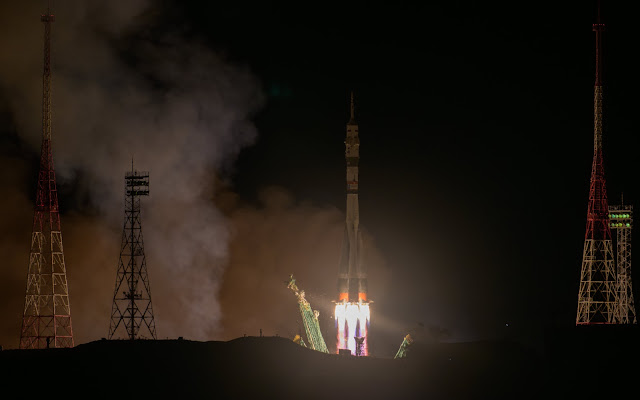Expedition 72 Crew: Launch Day in Kazakhstan | International Space Station
Expedition 72 crew members: Roscosmos cosmonaut Ivan Vagner (Russia), top, NASA astronaut Don Pettit, middle, and Roscosmos cosmonaut Alexey Ovchinin (Russia), wave farewell prior to boarding the Soyuz MS-26 spacecraft for launch, Wednesday, Sept. 11, 2024 at the Baikonur Cosmodrome in Kazakhstan.
NASA Associate Administrator for the Space Operations Mission Directorate, Ken Bowersox, left, and NASA International Space Station (ISS) Program Operations Integration Manager, Dina Contella, right, walk NASA astronaut Don Pettit to the Soyuz rocket for boarding, Wednesday, Sept. 11, 2024 at the Baikonur Cosmodrome in Kazakhstan.
The Soyuz rocket is seen on the launch pad at Site 31, Wednesday, Sept. 11, 2024, at the Baikonur Cosmodrome in Kazakhstan. Expedition 72 crew members: NASA astronaut Don Pettit, Roscosmos cosmonauts Alexey Ovchinin, and Ivan Vagner of Russia, are scheduled to launch aboard their Soyuz MS-26 spacecraft later in the evening.
Soyuz 2.1a launch vehicle with Soyuz MS-26 crewed spacecraft on Pad 31 at the Baikonur Cosmodrome in Kazakhstan.
Bishop Ignatii of Kyzylorda and Aktobe, center, prepares to bless the Soyuz rocket as Roscosmos cosmonaut Oleg Artemyev of Russia, left, looks on, Tuesday, Sept. 10, 2024, at the Baikonur Cosmodrome site 31 launch pad in Kazakhstan.
Bishop Ignatii of Kyzylorda and Aktobe blesses the Soyuz rocket, Tuesday, Sept. 10, 2024, at the Baikonur Cosmodrome site 31 launch in Kazakhstan.
Bishop Ignatii of Kyzylorda and Aktobe blesses the Soyuz rocket, Tuesday, Sept. 10, 2024, at the Baikonur Cosmodrome site 31 launch in Kazakhstan.
NASA astronaut Don Pettit's Soyuz MS-26 spacesuit
NASA astronaut Don Pettit, along with Roscosmos cosmonauts Alexey Ovchinin and Ivan Vagner of Russia, will launch aboard the Soyuz MS-26 spacecraft at 12:23 p.m. EDT Wednesday, Sept. 11. Following launch, the trio will take a short ride to the International Space Station and dock at 3:33 p.m. to the Rassvet module before opening the hatches and joining the Expedition 71 crew in orbit, where they will spend approximately six months living and working in space.
NASA Astronaut Donald R. Pettit Biography:
https://www.nasa.gov/people/donald-r-pettit/
https://www.nasa.gov/humans-in-space/astronauts/donald-r-pettit/
Expedition 71 Crew
Station Commander: Oleg Kononenko (Russia)
Roscosmos (Russia): Nikolai Chub, Alexander Grebenkin (Russia)
NASA: Tracy Dyson, Matthew Dominick, Mike Barrett, Jeanette Epps, Suni Williams, and Butch Wilmore
An international partnership of space agencies provides and operates the elements of the International Space Station (ISS). The principals are the space agencies of the United States, Russia, Europe, Japan, and Canada. The ISS has been the most politically complex space exploration program ever undertaken.
Image Credit: NASA/Bill Ingalls
Image Dates: Sept. 8-10, 2024
#NASA #Space #ISS #Science #Earth #BaikonurCosmodrome #Kazakhstan #SoyuzRocket #SoyuzMS26 #SoyuzCrewSpacecraft #Astronaut #DonPettit #UnitedStates #Cosmonauts #AlexeiOvchinin #IvanVagner #Russia #Россия #Roscosmos #Роскосмос #SpaceLaboratory #Expedition72 #HumanSpaceflight #InternationalCooperation #STEM #Education














ESO-1080p.jpg)













